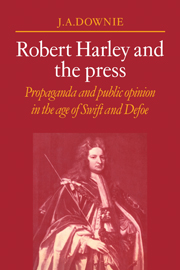Book contents
- Frontmatter
- Contents
- Preface and Acknowledgements
- Author's note
- Introduction
- Part one 1689–1708
- Part two 1708–1714
- 5 The tory resurrection, 1708–1710
- 6 Swift, Defoe, and the peace campaign
- 7 The stamp act of 1712
- 8 The organisation of propaganda, 1710–1714
- Epilogue: impeachment and after
- Abbreviations
- Notes
- Index
8 - The organisation of propaganda, 1710–1714
Published online by Cambridge University Press: 07 October 2011
- Frontmatter
- Contents
- Preface and Acknowledgements
- Author's note
- Introduction
- Part one 1689–1708
- Part two 1708–1714
- 5 The tory resurrection, 1708–1710
- 6 Swift, Defoe, and the peace campaign
- 7 The stamp act of 1712
- 8 The organisation of propaganda, 1710–1714
- Epilogue: impeachment and after
- Abbreviations
- Notes
- Index
Summary
Although Defoe and Swift were the biggest wheels in the government's propaganda machine, there were other cogs to ensure its smooth functioning. Defoe, again in contrast to Swift, was a loner, and he was probably the only propagandist with whom Swift had no contact, and over whom he exercised no control. Oxford retained Defoe's services as a personal propagandist. Not even Bolingbroke was aware of the prime minister's connections with Defoe. But a team of writers surrounded Swift on the tory side, and in this sense he can be said to have organised government propaganda for the Oxford ministry. He was the middle man between the ministers and both the party hacks and the printers. His opinion was sounded on the quality of tory propaganda, and on the need for pamphlets on certain questions. Although this was evident as early as the spring of 1711, it was really only after the resolution of the peace crisis a year later that he began to act as chef de propagande. He was free from the responsibility of regular editorship of the Examiner, and he had no major writings to prepare. ‘I have nothing to do now, boys’, he wrote on 29 February 1712, ‘and yet I was dictating some trifles this morning to a printer’. After the anxieties of December 1711 and Oxford's creation of twelve court peers, the government propaganda machine was able to tick over under its own steam, with the minimum of ministerial supervision.
- Type
- Chapter
- Information
- Robert Harley and the PressPropaganda and Public Opinion in the Age of Swift and Defoe, pp. 162 - 184Publisher: Cambridge University PressPrint publication year: 1979



